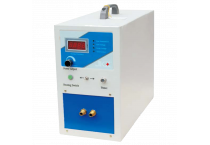-
- Generators power 500 W, frequency 150 - 400 kHz
- Generators power 1.2 - 2.4 kW, frequency 150 - 400 kHz
- Generators power 4.2 - 10 kW, frequency 150 - 400 kHz
- Generators power 10-15 kW, frequency 50-150 kHz
- Generators power 30-45 kW, frequency 50-150 kHz
- Generators power 65-135 kW, frequency 50-150 kHz
- Generators power 180-270 kW, frequency 50-150 kHz
- Generators power 20-35-50 kW, frequency 15-45 kHz
- Generators power 75-150 kW, frequency 15-45 kHz
- Generators power 200-500 kW, frequency 15-45 kHz
- Generators power 20-50 kW, frequency 5-15 kHz
- Generators power 75-200 kW, frequency 5-15 kHz
- Generators power 250-500 kW, frequency 5-15 kHz
- Generators power 75-250 kW, frequency 2 - 6 kHz
- Generators power 300-500 kW, frequency 2-6 kHz
What is the purpose of induction heating generators?
Induction generators convert alternating current to a higher frequency current to then deliver it to the operating coil, allowing an electromagnetic field to be created within it.
When a workpiece is placed in this field, eddy currents are induced in the workpiece. The friction caused by these currents generates precise, clean, non-contact heat. Depending on the power and on the frequency, we are able to determine the heating rate and the penetration depth of the heat.
A water cooling system is usually required to cool the work coil and induction system.
Operating frequency
The size of the workpiece and the heating application dictate the operating frequency of the induction heating equipment. In general, the larger the workpiece, the lower the frequency and the smaller the workpiece, the higher the frequency.
The operating frequency is determined by the tank circuit capacitance, coil inductance and workpiece material properties.
Power requirements
The power required to heat the workpiece depends on:
- The mass of your work piece;
- The material properties of your work piece;
- The temperature increase you require;
- The heating time required to meet your process needs;
- The effectiveness of the field owing to the coil design;
- Any heat losses during the heating process.
Once the power required to heat the workpiece is determined, the appropriate induction heating equipment can be selected, taking into account the coupling efficiency of the coil.








